The Portuguese paradise dotted with masterpieces of English sculpture
Tim Richardson takes a look at a slice of Portugal place famed for its English lead sculptures.
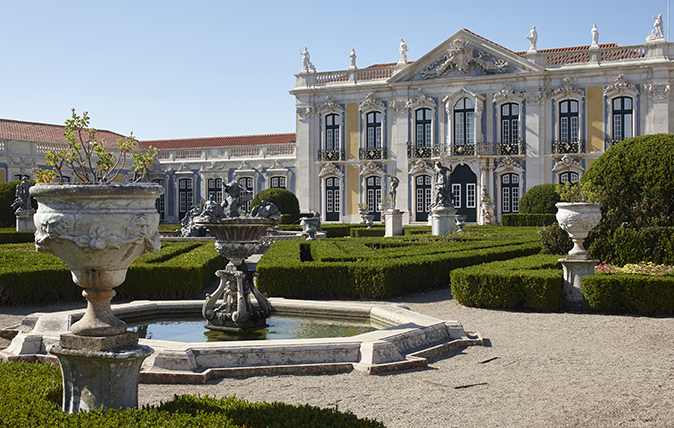

The royal estate at Queluz, 10 miles north-west of Lisbon, was established as a seat for the younger sons of the kings of Portugal in 1654. When, in 1747, the Infante Pedro—who became Pedro III 30 years later—began work on a new summer palace here, it was conceived as a personal expression of contemporary taste.
Dom Pedro’s original architect, Mateus Vicente de Oliveira, was called back to Lisbon to work on the city’s reconstruction after the great earthquake of 1755, so his erstwhile assistant Jean-Baptiste Robillion took on more responsibility for both palace and garden, adding the west wing, known as the Robillion Pavilion, a great external staircase and many garden features between 1760 and 1787.
For British visitors, Queluz is, above all, notable as the repository of the best surviving collection of English 18th century lead garden statuary. Most of it was imported from the workshop or ‘statuary’ of John Cheere of Hyde Park Corner in the years 1756 and 1757. Twenty Cheere statues and groups can still be enjoyed in the gardens of Queluz today, a number of them restored (2003–08) by Rupert Harris in London thanks to a grant from the World Monuments Fund.
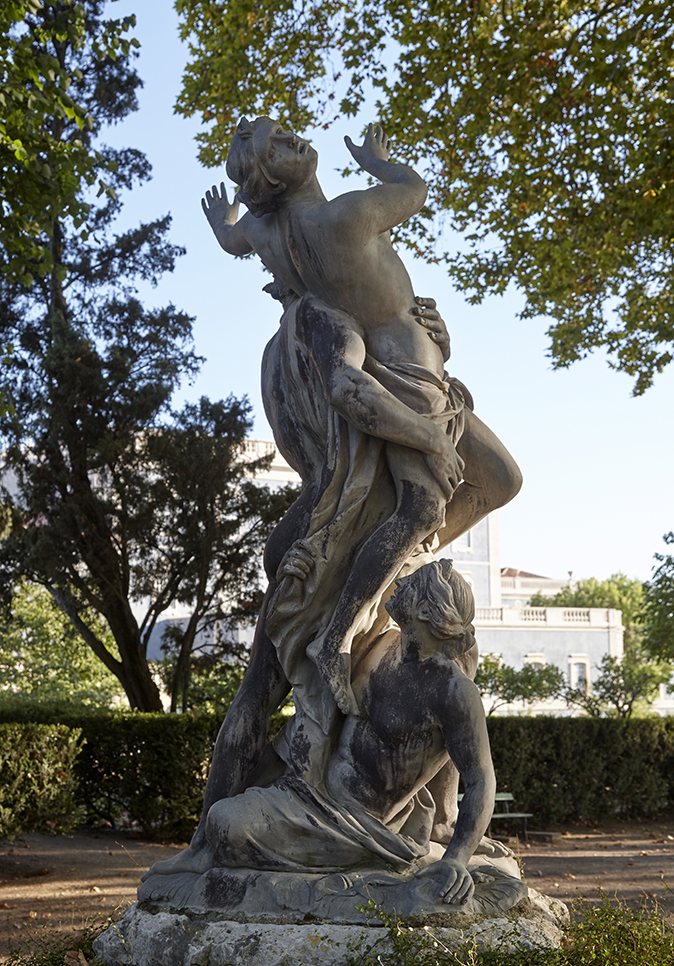
Lead statuary was historically regarded as a low-status artform (in contrast to stone or marble sculpture) and is notoriously vulnerable to theft. Relatively few pieces survive in British gardens, but that is not the only reason that this collection is remarkable. Cheere’s accounts show that most British clients bought lead pieces in ones and twos; the biggest single commission for a British garden, for example, was 19 lead statues (including a ‘Highland Lassie’) for Blair Castle, ordered by the 2nd Duke of Atholl.
This makes Queluz—with nine statue groups, 57 figures and 72 urns— seem prodigious indeed. Conveyed from London to Lisbon in two consignments, the order was authorised by the Portuguese ambassador in London, who had earlier sent Cheere’s catalogue back to Portugal.
A detailed inventory made at Queluz in 1763 reveals that many of the lead statues were painted in different colours for a lifelike appearance—for example, a shepherdess is recorded as having a white hat and dress, with a redand- green bodice—but it appears they were last repainted in the 1830s. The sheer range of themes—from the Seasons to animals to goddesses to Commedia dell’Arte figures—would seem to preclude any notion of a symbolic rationale.
'Animation, drama and a sense of human scale'
The generally accepted view of the sculpture at Queluz is that it was always intended to be used en masse as an integral element of an overall formal design, lending animation, drama and a sense of human scale to the garden as it unfolded episodically to the enrapt visitor. Such usage would have seemed old-fashioned to British observers, redolent as it was of the way sculpture was used in earlier Baroque gardens such as Versailles.
Sign up for the Country Life Newsletter
Exquisite houses, the beauty of Nature, and how to get the most from your life, straight to your inbox.
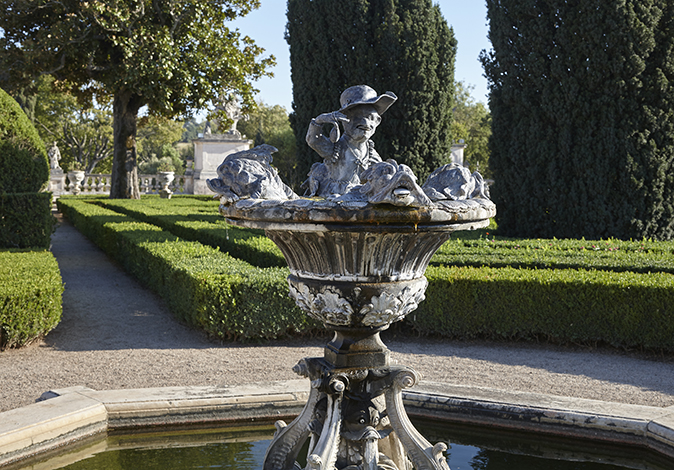
This reading of the sculpture as almost randomly arranged is reinforced by the fact that the sculptures were quite often moved around the garden. But perhaps an iconographical reading ought not to be discounted altogether. Many of the surviving lead statues at Queluz are congregated on the parterres south of the palace. A Dutch head gardener named van der Kolk, who started work at Queluz in 1755, tended these formal gardens and there is a record of 1,450 cherry laurel bushes being imported from Amsterdam in 1758, as well as hundreds of box and yew topiaries in the years before. As box blight has been a particular problem recently, a decision has been made gradually to replace all the box with myrtle.
The palace’s south façade, built in the 1760s, but reduced by a fire in 1934, overlooks a parterre known as the Neptune Garden or as the Hanging Garden, as it forms the roof of a great hidden cistern created by Robillion.
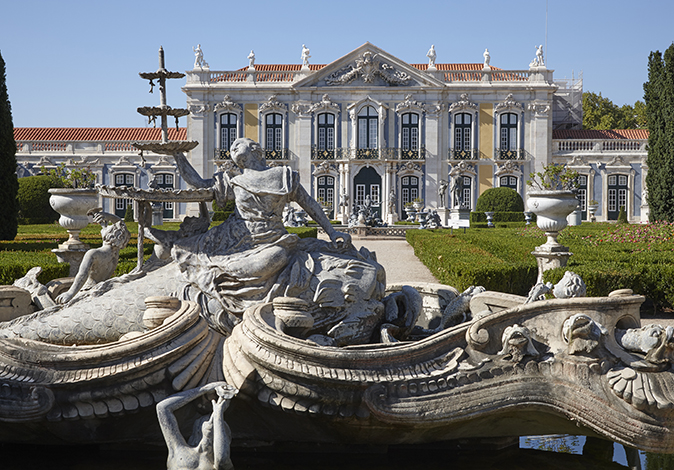
Its eponymous Neptune Pool, one of four in the overall layout, is surrounded by Cheere statues of the seasons and two groups: Vertumnus with Pomona and Meleager with Atalanta.
A pair of small fountains centred on monkey statues flanks the parterre and the Fountain of the Nereid (probably installed after Robillion’s period of influence) contains one of Cheere’s most ambitious ensembles.
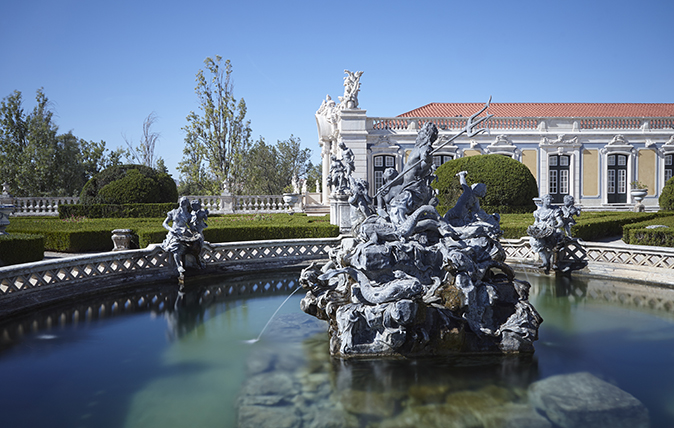
Beside this is a smaller parterre based on a cruciform pattern, known as the Malta Garden. It is laid out in proportion with the east wing of the palace (which incorporates the Throne Room) and is enclosed by an elegantly formed platform of five steps. Among its sculptural ornaments are six delightful putti ensembles of stone acquired in Genoa between 1757 and 1765 and a central fountain with an exquisite scallop-shell base.
This detail may be drawn from contemporary silverware design; there is evidence that Robillion, a Huguenot, began his career as a silversmith. The fountain is adorned by a pair of putti ensembles and surrounded by statues representing the Arts.
The unfortunate side effect of restoration to working order
The central axis of the Neptune Garden leads out into the lower park through the Gate of Fame, an open gateway with twin statues on pedestals of a trumpet-blowing Fame mounted on Pegasus, made in 1771 by Manuel Alves and Filipe da Costa. Beyond is a typical Baroque arrangement of carriage rides and intersections, with the remains of woodland bosquets (mainly limes and elms originally) set within palisades in the areas between.
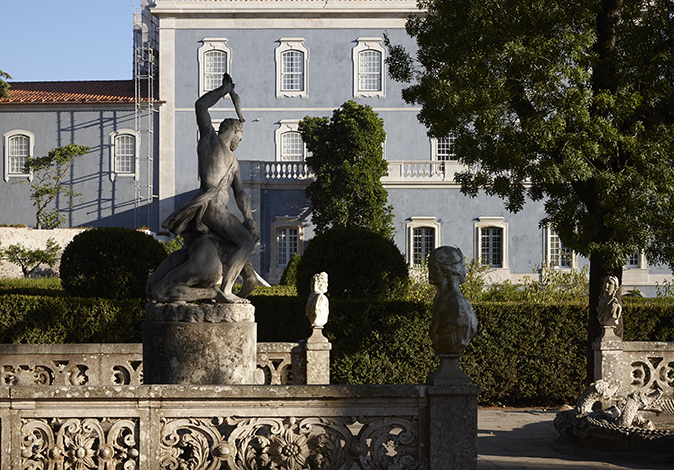
These features are among the current restoration priorities at Queluz: the palisades are being replanted to a consistent 5m (about 16ft) height, the new gravel is grey-yellow granite sand and the gutters are of basalt. The main axis terminates at a great free-standing cascade of 1770, which was restored to working order in 2007, although an unfortunate side effect was that the water turned the stonework black.
The cascade is today a difficult feature to read, lacking its balustrade with statuary and also its intended grove-like setting, which incorporated 18 busts on plinths forming an exedra to complete the circle. The discovery of flanking foundations suggests the original intention may have been for a more substantial feature, which would have been more in the spirit of Italian originals.
Tucked away in the north-west corner of the estate is the Botanic Garden, which was created between 1769 and 1776 and has recently been the subject of a restoration project. Four rectangular hothouses for pineapples (Ananas comosus Cayenne) bookend a geometric arrangement of botanical ‘order beds’ and a central pool with dog statues at the corners.
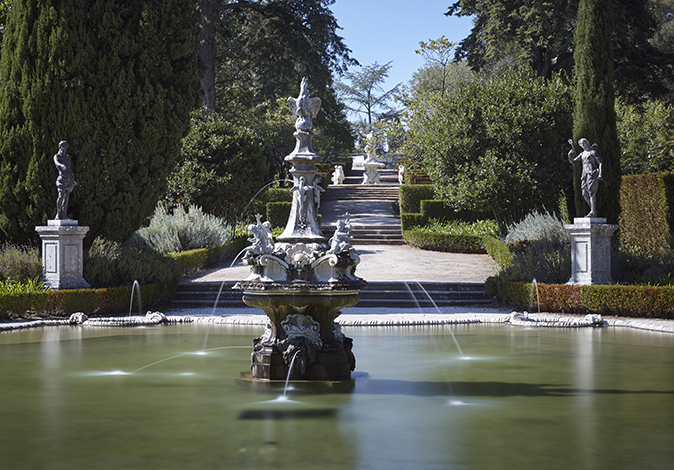
Each hothouse contains fruits at a different stage of maturation. A ‘Chinese house’ is mentioned in several accounts, but no archaeological evidence has been forthcoming, so a decision has been taken not to rebuild it according to a conjectural design. The area to the north-west of the palace was a festive zone that was used chiefly for fêtes champêtres. Dom Pedro had a passion for fireworks while lantern shows were another amusement, sometimes designed in conjunction with fountains and cascades.
There were many diversions in this part of the garden, including a menagerie— its lions and tigers caged beside the (newly restored) Shell Cascade are recorded as late as 1833—a miniature wooden palace known as the Barraca Rica, a billiards pavilion, gilded aviaries and even a small bullring. Robillion also built an expansive external stair here that offered an appropriately regal descent from the palace to a grand canal, the focus of entertainments in the garden.
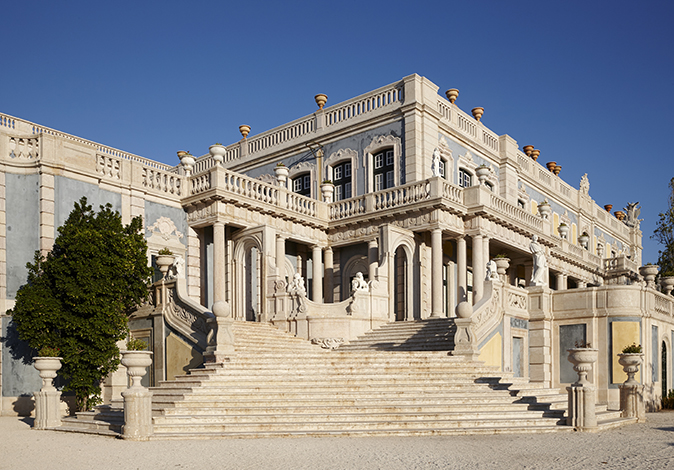
Today, the 375ft-long canal—which is, in fact, a spur of the River Jamor— is confined to a small rill. In the 18th century, however, this spectacular tiled trench was filled on special occasions to form a ‘lake’ for pleasure boats. Musicians were placed in a ‘Chinese building’, which formed a bridge over the canal.
Music was, for a long period, an important part of life at Queluz, with operas and concerts performed in the palace’s own opera house (later replaced by the Doña Maria Pavilion (1789) at the southern end of the palace complex).
Finally, an avenue of sycamore trees directly north of the palace shades the most dramatic and dynamic of the surviving Cheere statue groups, including Cain and Abel and The Rape of Proserpine.
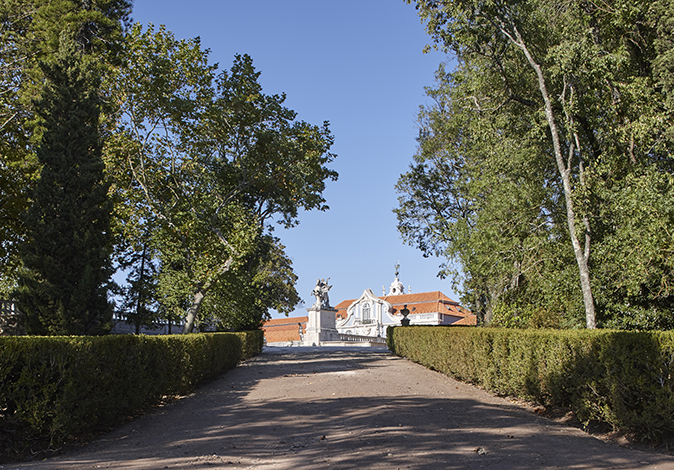
The underlying symbolic themes in the garden
An axis leading north from here, up a gentle hill, leads first to the Pool of the Medallions, a deliciously low, scallop-edged pool that is perhaps the most attractive of all Robillion’s pools at Queluz. A pair of Cheere statues—Diana and Apollo—lends the scene even more elegance. This area was designated a flower garden, the Jardim Novo, in the 1760s, but no trace of this survives. Further along this axis is another fountain dedicated to Neptune (1677), which is not original to Queluz, and, beyond that, the stables of the Portuguese School of Equestrian Art.
It is possible to tease out underlying symbolic themes in the garden. The emphasis in the Malta Garden on the Arts and on innocent children safely playing among wild animals could be understood as a kind of paradise around the motif of the cross. The Neptune Garden might symbolise the harnessing of Earth and the Elements for the benefit of humankind—the maritime theme being the most apposite for Portugal in this regard—as well as fallen humanity, represented by the mischievous monkeys dressed in human clothes.
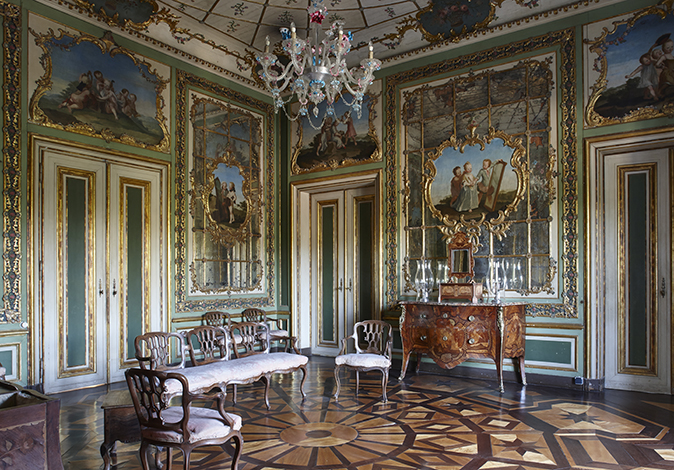
Certain figures on the balustrade dividing this enclosed garden from the park dramatically presage the ‘chaos’ of the wilderness beyond, most notably Pan. Another layer of symbolism might be expressed in the park and farther reaches of the estate, whose glades and allées are replete with animal statuary as well as—historically— many real animals in aviaries and menageries; dark or violent figures such as satyrs; capricious and cruel pagan deities or those associated with woodland, such as Pan and Diana; and physical intimations of wilderness including the cascade and the canal.
This realm can be understood as a celebration of the raw power of God’s creation and its incipient danger, but also the unlimited potential of its bounty. Beyond this, there was formerly a large working estate that extended many miles in each direction. The garden might be seen to move from the chaos of untamed nature, through its divinely sanctioned exploitation by humans, to a higher state, which might be equated with Paradise or Heaven, overlooked by the Throne Room.
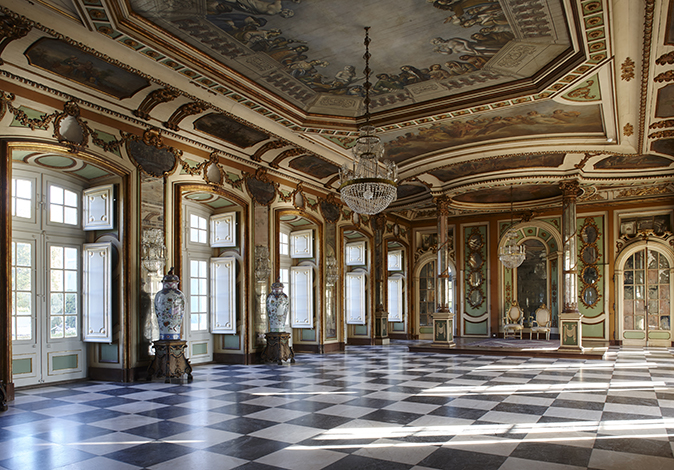
Such a cosmic hierarchy would have been familiar from the Italian Renaissance garden tradition— a very similar narrative can be discerned at Villa Lante, for example. It is a journey that, thanks to the recent restoration work, the modern visitor can once more begin to imagine.
Tim Richardson
Country Life is unlike any other magazine: the only glossy weekly on the newsstand and the only magazine that has been guest-edited by HRH The King not once, but twice. It is a celebration of modern rural life and all its diverse joys and pleasures — that was first published in Queen Victoria's Diamond Jubilee year. Our eclectic mixture of witty and informative content — from the most up-to-date property news and commentary and a coveted glimpse inside some of the UK's best houses and gardens, to gardening, the arts and interior design, written by experts in their field — still cannot be found in print or online, anywhere else.
-
 380 acres and 90 bedrooms on the £25m private island being sold by one of Britain's top music producers
380 acres and 90 bedrooms on the £25m private island being sold by one of Britain's top music producersStormzy, Rihanna and the Rolling Stones are just a part of the story at Osea Island, a dot on the map in the seas off Essex.
By Lotte Brundle
-
 'A delicious chance to step back in time and bask in the best of Britain': An insider's guide to The Season
'A delicious chance to step back in time and bask in the best of Britain': An insider's guide to The SeasonHere's how to navigate this summer's top events in style, from those who know best.
By Madeleine Silver